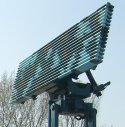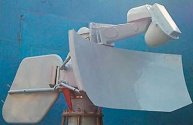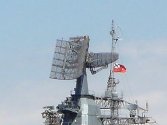Inferiror compared to the the big array on Top Plate. It is has about 2/3 of the height and works on a lower frequency (higher wavelength). One reason he mentions for having the two arrays operate in two distinct frequency bands is to provide frequency diversity for ECCM (this was in reference to the Plate Steer).
I think he was quoting marketing material. For the single face variants of Fregat-MA, like the MAE-4K, he explicitly mentioned Abu Dhabi, 1993 as the source. But OK, this is slowly becoming ancient stuff by now.
SM-2 also added automatic inertial navigation, which was a big thing back then. This way the missile can follow a designated path of setpoints even after the tracking radar can no longer "see" it. Because such a "blind" missile might increasingly deviate from target as time goes by, the terminal illumination needs to be started earlier compared to AEGIS which uses the SPY-1 to guide the missile until it is only a few seconds away from hitting the target.
I was comparing only the X-band CWI components. The 4kW average power on SPG-51 is solely for the X-band CWI. The C-band tracking radar has a separate feed, but shares the same antenna.
The Mk 74 Mod 15 which was installed on the Kidds before they were transferred to ROC, has an addtional X-band CWAT (continuous wave acquisition and track) radar via a secondary antenna. Friedman included a photo of the setup in his book, but I cannot find it in photos available online. Wikipedia page for SPG-51 claims the same:
You got it backwards. The bigger array on the Top Plate has the lower frequency and the smaller array has the higher frequency, as often arrays are because a lower frequency means a larger waveform requires proportional separation between the elements resulting in a bigger, less dense array. So bigger array, lower frequency, smaller array, higher frequency. Whatever is lost with the smaller array is gained back with the higher frequency. This has nothing to do with ECCM. The higher frequency is for less clutter for scanning flying targets near the water's surface. The use of two array faces and a higher frequency on one array face also improves on the track quality of the target. If we were to go with NATO instead of IEEE on the wave bands, one array on the Top Plate might be on E band and the other might be on F-band.
You can see from the picture below that the smaller array has a finer grate, with smaller but more rows. That's a higher frequency with less separation between the elements for a more dense array.
MAE-4K is still being marketed but has never found a buyer since it was offered. It has zero relevance when it comes to the Sovremenny as the ship never used this. See also below.
Even if inertial navigation is used, you need high quality track on the target, and against a high maneuvering target, automatic set point inertial navigation can quickly find its given path obsolete and can be far off from the target when it needs to go terminal. That's the same point you made. So you have to go terminal earlier and light up the target sooner. If the target receives an X-band CWI alert from its RWR, it will perform evasions and countermeasures, so your odds of PK gets lower. The target would already be in an alert state when it receives the C-band pulse so it knows its already under weapons quality track. This scheme of using an inertial navigation system sounds more effective in closer ranges than it is far.
The way the MR90 or any other Soviet SAM radar works, like Tombstone, is that it uses FMCW on TWS, and at this point, the target does not know if a missile is fired or not, only that a fire control radar has already illuminated it.
In addition to Top Plate, what the other two PLAN Sovremenny is using the Pozitiv ME radar at the rear. This is the X-band radar also used for surveillance and air defense. None of the Soviet or 'generic' Sovremenny have this radar.
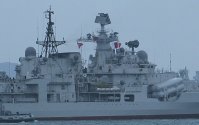
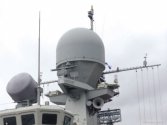
It has three different versions, and appears to be a phase array with frequency scanning.
I don't know if Friedman might be mixing this up.
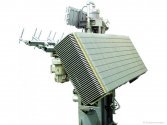
While it is said to be meant for servicing the Kashtans, it might as well be servicing the MR90 Orekhs with weapon quality track and queuing them to their targets, leaving the Fregat free for search mode only. This will do a better job for anti-clutter in surface scanning with its X-band, so the dual band on the Fregat becomes moot. The advantage of using this over the Fregat for queuing the MR90s is because the Fregat might give a more loose track, and the MR90 will have to compensate with additional scans. If this is the queuing radar, the MR90s can be silent but already accurately aimed at the targets, and less time is needed for compensating for a faster reaction time against the target. The target itself will not be illuminated by the MR90s, but by this, which give an X-band pulse instead of a CW.
